In a recent story posted in early April, the Hindustan Times online said that signs of unease emerging between China and Pakistan over the future of the China-Pakistan Economic Corridor (CPEC), citing a report published in Modern Diplomacy. However, experts based in Pakistan told the Global Times a different version of the story.

The Orange Line Metro Lahore welcomes the first batch of passengers on October 26, 2020. Photo: VCG
Muhammad Zamir Assadi, a journalist from Independent News Pakistan, told the Global Times on Saturday that CPEC, the symbol of modern development and progress under the dynamic Belt and Road Initiative (BRI), has emerged as a cornerstone of growth in Pakistan. The Orange Line Metro Lahore, Pakistan's first metro line, begins commercial operations in the eastern city of Lahore, the second largest city in Pakistan, on October 25, 2020. Photo: VCG
"The commitment of China and Pakistan with the passion of friendship having the history of seven decades has been pushing forward the smooth construction of CPEC projects illustrating the deep understanding between two sides," he said.
Contrary to the report by the Modern Diplomacy, people of Pakistan are enjoying the various benefits of CPEC, said the journalist.
Ushering into its second phase, CPEC is focusing on innovating local growth models and transforming the overall trajectory of sustainable development.
Syed Hasan Javed, director of China Studies at the Center of National University of Science and Technology in Islamabad, Pakistan, told the Global Times that progress achieved in the implementation of the three-dozen-plus projects as part of early harvest phase-I (2015-20) has been commendable, and a source of great satisfaction for both countries.
Tangible benefits
The benefits cultivated under CPEC include the creation of more than 70,000 direct jobs for the residents, the contribution of one to two percentage points to Pakistan's GDP growth, Assadi noted.
Meanwhile, as a regional trade hub, the development of Gwadar port has created thousands of scholarships for Pakistani students and the establishment of vocational training centers. Under construction, Gwadar airport and others are the manifestations that projects on the ground are moving ahead smoothly without any barriers, he said.
CPEC has already contributed to resolving supply-side challenges and bottlenecks such as electricity load shedding, infrastructure, and communication issues. Now Pakistan is poised for economic take-off which may surprise those who do not wish it well, but Pakistan's history of achievements is a testimony that it has indeed achieved what it has aimed for, Javed said.
Assadi also finds it noteworthy that BRI has come up as the only project that was working on its pace for fulfilling the needs of development in various countries during the COVID-19 pandemic.
"It has been recognized as a kind of initiative that did not face any halt during the pandemic and was even providing new jobs for the locals in respective countries," said Assadi.
The Chinese assistance to Pakistan under the Health Silk Road, a concept regarding the provision of COVID-19 testing kits and the vaccines, has also helped Pakistan contain the pandemic to a certain level, he added.
In the initial seven years, CPEC attracted the direct investment of more than $25 billion that helped in tackling the worst energy crisis in the country and laid the foundation for the construction of modern highways and motorways including the completion of Pakistan's first electric-powered public transport project known as Orange Line Metro Line that opened the doors for innovative subways, Assadi noted.

Indian media and some Western media outlets with the exaggerated analysis of so-called experts are trying to undermine the development of CPEC for their own reasons, according to Assadi.
These are the media outlets who have never sent their correspondents to visit Pakistan to observe the genuine development, Assadi pointed out.
Javed echoed Assadi's point of view.
"No nation should challenge our resolve to succeed. The rise of China cannot be thwarted, come what may! Similarly, the BRI and CPEC are realities and success stories, which cannot be denied by hyped fake propaganda and disinformation campaigns," Javed said.
The CPEC has been a great success story so far! It has surprised the hostile powers, detractors and skeptics whose whoppers, calculations, and propaganda failed, Javed stressed.
Javed finds it necessary for both China and Pakistan to develop a comprehensive, integrated, and well-managed media strategy on CPEC and BRI.
"Pakistani and Chinese media outlets should establish a joint strategy to refute the baseless reports by those media groups and should present the comprehensive reports on CPEC development [in a] timely [fashion] for the appetite of local and international audience," Assadi said.
Recommendations
Even though the external propaganda and disinformation do not impact the actual progress of the CPEC projects, these create some confusion in the masses, Javed warned.
He suggested that both countries hence need to filter such inspirational, motivated and mischievous reports. The evolution of the global situation calls for greater collaboration.
He stressed that both countries need to enhance communication.
"Our Chinese friends are already providing thousands of scholarships to young Pakistanis for higher education in China," Javed said.
Both countries need to avoid misperceptions due to the lack of communication and narrative.
"Stakeholders on both sides need to have frequent interactions and enhance institutional linkages," he said.




